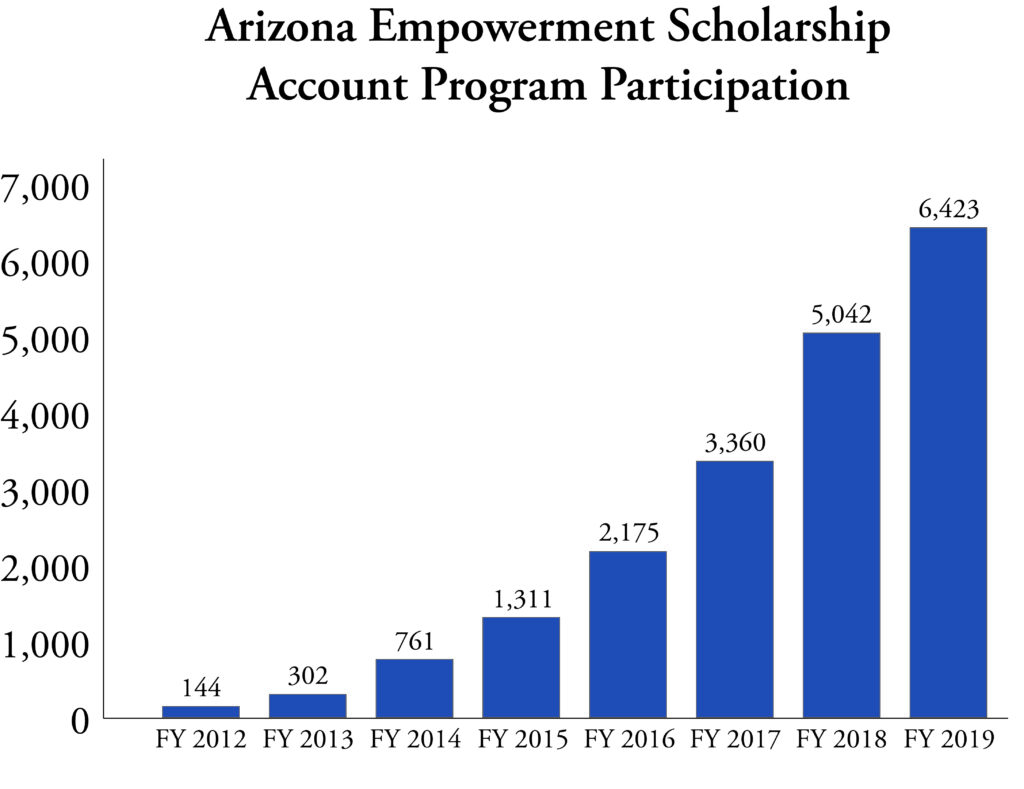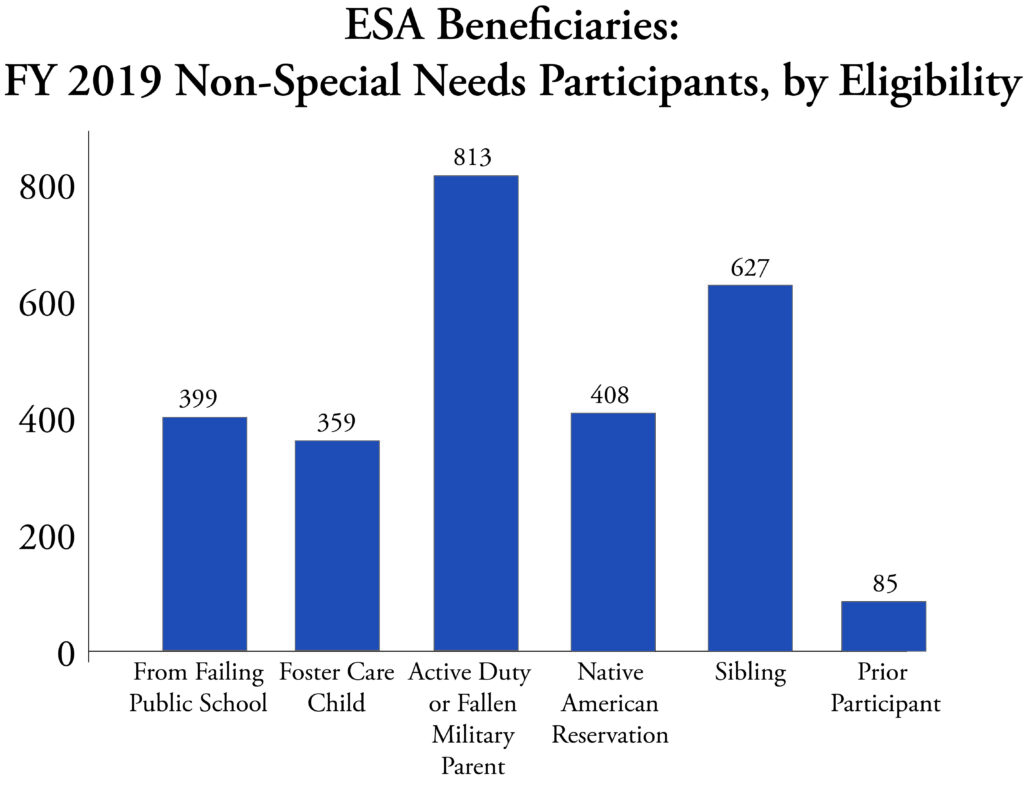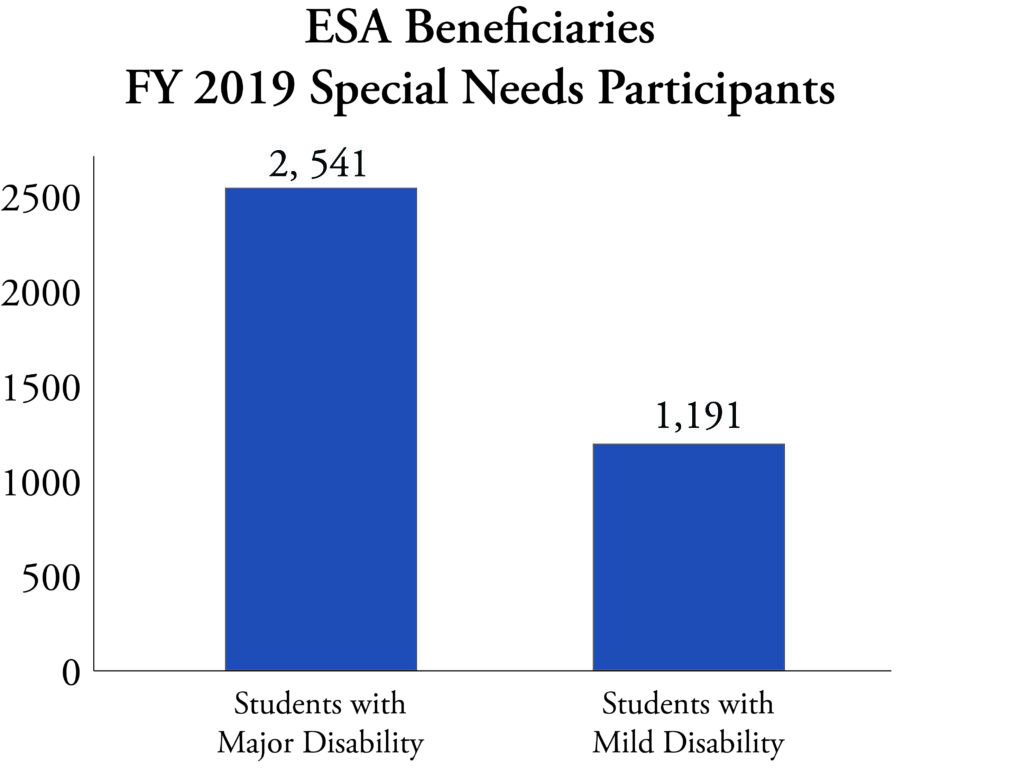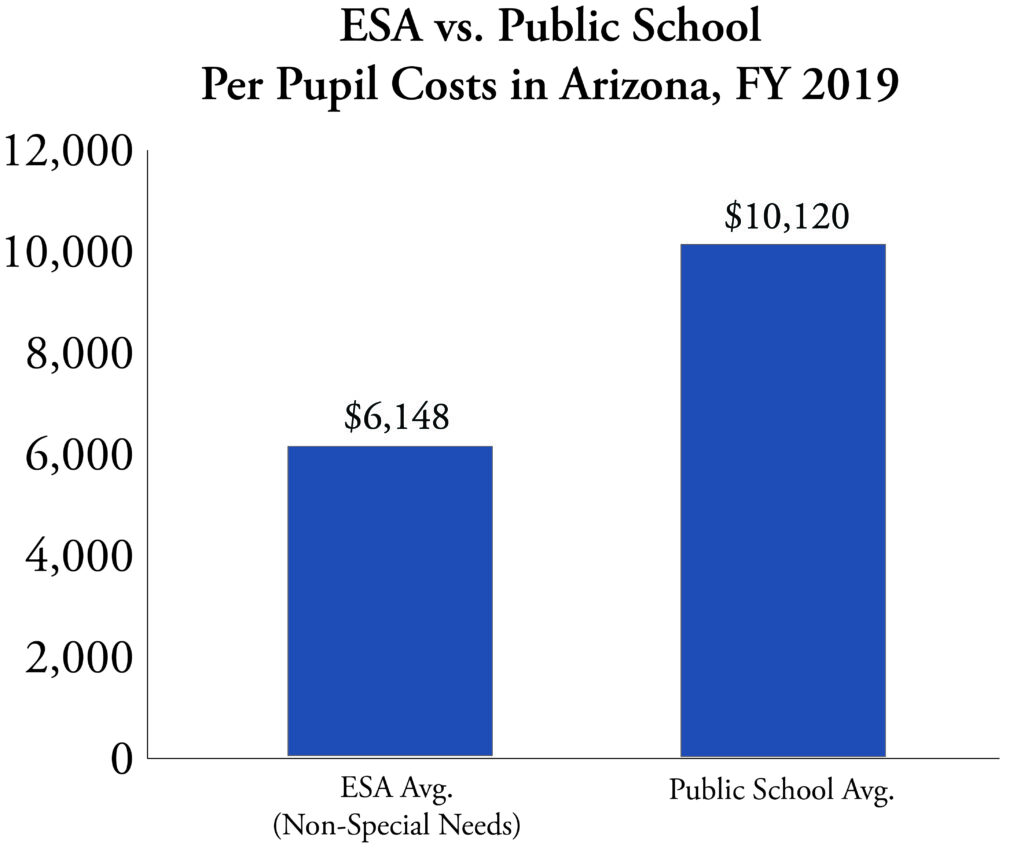End Notes
1 HB 2474, “Lifeline for Student Crime Victims Act,” Arizona 54th State Legislature, First Regular Session. https://apps.azleg.gov/BillStatus/GetDocumentPdf/463938; Policy Brief: Education Savings Accounts, National Education Association, https://www.nea.org/assets/docs/20406_Policy%20Brief_rev2.pdf.
2 “Gov. Lee Signs Voucher Bill Into Law Despite Outrage from House Democratic Caucus,” Fox 17 News, May 24, 2019, https://fox17.com/news/local/gov-lee-signs-voucher-bill-into-law-despite-outrage-from-house-democratic-caucus; Patrick Gleason, “Strike in West Virginia Demonstrates How Teachers Unions Oppose School Choice, As Well As Tax Relief.” Forbes, February 19, 2019, https://www.forbes.com/sites/patrickgleason/2019/02/19/west-virginia-demonstrates-how-teachers-unions-oppose-school-choice-as-well-as-tax-relief/#6a2a829a60b5.
3 FY 2020 Appropriations Report – Department of Education and School Facilities Board Agency Sections. Arizona Joint Legislative Budget Committee, June 2019, https://www.azleg.gov/jlbc/20AR/ade.pdf.
4 Jonathan Butcher, Education Savings Accounts: A Path to Give All Children an Effective Education and Prepare Them for Life, Goldwater Institute, October 28, 2014, https://www.goldwaterinstitute.org/wp-content/uploads/cms_page_media/2015/2/2/PR253ESAsPathToAllChildren_0.pdf.
5 Arizona Revised Statutes Section 15-2402, https://www.azleg.gov/viewdocument/?docName=https://www.azleg.gov/ars/15/02402.htm.
6 Jonathan Butcher, “North Carolina Becomes Sixth State with Education Savings Accounts,” Goldwater Institute, June 29, 2017, https://www.goldwaterinstitute.org/article/north-carolina-becomes-sixth-state-with-education-savings-accounts/. Note: Due to the Nevada State Legislature’s failure to appropriate funding, the Nevada ESA program never received funding for implementation: Teresa Mull, “Nevada Legislature Fails to Fund State’s Education Savings Account Program,” Heartland Institute, August 8, 2017, https://www.heartland.org/news-opinion/news/nevada-legislature-fails-to-fund-states-education-savings-account-program.
7 FY 2020 Baseline Book–Department of Education. Arizona Joint Legislative Budget Committee, January 2019, https://www.azleg.gov/jlbc/20baseline/ade.pdf.
8 Ibid.
9 All Arizona K-12 Funding, Arizona Joint Legislative Budget Committee, July 10, 2018, https://www.azleg.gov/jlbc/allfunding2001.pdf.
10 Author’s calculations of FY 2019 ESA program data provided by the Arizona Department of Education, April 23, 2019; All Arizona K-12 Funding, Arizona Joint Legislative Budget Committee, July 10, 2018, https://www.azleg.gov/jlbc/allfunding2001.pdf.
11 Author’s calculations of FY 2019 ESA program data provided by the Arizona Department of Education, April 23, 2019.
12 EJ Montini, “Expanded School Voucher Scam (Prop. 305) Is Even Worse than We Thought,” Arizona Republic, October 29, 2018, https://www.azcentral.com/story/opinion/op-ed/ej-montini/2018/10/29/empowerment-scholarship-account-prop-305-arizona-vouchers/1816405002/.
13 Arguments Submitted Against Prop. 305, Arizona Secretary of State, November 2018, https://azsos.gov/sites/default/files/Arguments_Against_Prop_305.pdf.
14 Author’s calculations of FY 2019 ESA program data and FY 2019 unweighted special education student counts as reported in Arizona Department of Education, April 22, 2019, school payment data, http://www.ade.az.gov/extracts/Apportionment/.
15 Arizona Joint Legislative Budget Committee, Senate Bill 1431, Fiscal Note, February 2017, https://apps.azleg.gov/BillStatus/GetDocumentPdf/448668.
16 FY 2020 Baseline Book – Department of Education.
17 Kelly Powell and Ildi Laczko-Kerr, Are District Attendance Zones Obsolete?, Center for Student Achievement, November 2, 2017, https://centerforstudentachievement.org/are-district-attendance-zones-obsolete/.
18 All Arizona K-12 Funding, Arizona Joint Legislative Budget Committee, July 10, 2018, http://www.azleg.gov/jlbc/allfunding2001.pdf; “Gov. Ducey’s FY 2019 Budget Plan Fails Arizona Schools,” Budget & Taxes (blog), Children’s Action Alliance, January 12, 2018, https://azchildren.org/gov-duceys-fy-2019-budget-plan-fails-arizona-schools.
19 All Arizona K-12 Funding, Arizona Joint Legislative Budget Committee, July 10, 2018, http://www.azleg.gov/jlbc/allfunding2001.pdf.
20 FY 2020 Classroom Site Fund Estimates, Arizona Joint Legislative Budget Committee. March 20, 2019, http://www.azleg.gov/jlbc/CSF-FY2020-032919.pdf.
21 FY 2020 Baseline Book – Department of Education.
22 Arizona Department of Revenue – 2017 Public School Report: Individual Income Tax Credit for the Support of Extracurricular Activities or Character Education Programs, Arizona Department of Revenue Office of Economic Research and Analysis, June 2018, https://azdor.gov/sites/default/files/media/REPORTS_CREDITS_2017_publicschoolreport.pdf.
23 2018 Annual Report of the Office of the Superintendent, Vol. I, Arizona Department of Education, January 2019, http://www.azed.gov/superintendent/superintendents-annual-report/.
24 Ibid.; Study of the Title I, Part A Grant Program Mathematical Formulas, National Center for Education Statistics, U.S. Department of Education, May 2019, https://nces.ed.gov/pubs2019/2019016.pdf.
25 Lindsey Luebchow, “Does Title I Funding Go Holy to Fund Private School Students?,” New America, April 16, 2008, https://www.newamerica.org/education-policy/federal-education-budget-project/ed-money-watch/does-title-i-funding-go-holy-to-fund-private-school-students/.
26 Study of the Title I, Part A Grant Program Mathematical Formulas, National Center for Education Statistics, U.S. Department of Education, May 2019, https://nces.ed.gov/pubs2019/2019016.pdf.
27 Mark Dynarski and Kirsten Kainz, Why Federal Spending on Disadvantaged Students (Title I) Doesn’t Work, Brookings Institution, November 20, 2015, https://www.brookings.edu/research/why-federal-spending-on-disadvantaged-students-title-i-doesnt-work/.
28 Arizona K-12 School Finance Statistics, Arizona Tax Research Association, January 2017, http://www.arizonatax.org/sites/default/files/publications/special_reports/file/breaking_down_k-12_stats_v2_0.pdf.
29 FY 2019 Appropriations Report, Arizona Joint Legislative Budget Committee, June 2018, www.azleg.gov/jlbc/19AR/ade.pdf.
30 FY 2018 Appropriations Report, Arizona Joint Legislative Budget Committee, June 2017, www.azleg.gov/jlbc/18AR/ade.pdf; FY 2017 Appropriations Report Arizona Joint Legislative Budget Committee, June 2016, http://www.azleg.gov/jlbc/17AR/ade.pdf.
31 Laws 2019, Chapter 263, Arizona 54th State Legislature, First Regular Session, https://www.azleg.gov/legtext/54Leg/1R/laws/0263.pdf.
32 Derek Staahl, “Douglas: AZ School Finance System a Cybersecurity Risk; uses ‘Windows 2000,’ AZFamily.com, January 22, 2018, https://www.azfamily.com/archives/douglas-az-school-finance-system-a-cybersecurity-risk-uses-windows/article_1cb60f30-55eb-5568-b260-7bd3d9150e43.html.
33 Benjamin Scafidi, The Fiscal Effects of School Choice Programs on Public School Districts, Friedman Foundation for Educational Choice, March 2012, https://files.eric.ed.gov/fulltext/ED529881.pdf.
34 Scafidi, Fiscal Effects; Arizona Revised Statutes Section 15-949, https://www.azleg.gov/viewdocument/?docName=https://www.azleg.gov/ars/15/00949.htm.
35 Scafidi, Fiscal Effects.
36 FY 2020 Appropriations Report – School Facilities Board, Arizona Joint Legislative Budget Committee, June 2019, https://www.azleg.gov/jlbc/20AR/sfb.pdf.
37 Lisa Irish, “Special Education Funding Gap Squeezes Arizona Classrooms,” Arizona Education News Service, October 12, 2017, https://azednews.com/special-education-funding-gap-squeezes-arizona-classrooms/.
38 “ESAs Don’t Save the State Money,” Arizona School Boards Association, https://azsba.org/wp-content/uploads/2017/02/Arizona-Empowerment-Scholarship-Accounts_FINAL.pdf. Accessed May 15, 2019.
39 All Arizona K-12 Funding, Arizona Joint Legislative Budget Committee, July 10, 2018, http://www.azleg.gov/jlbc/allfunding2001.pdf.
40 “Which School Districts Lose the Most Students to Private School Vouchers?” Arizona Republic, 2019, https://www.azcentral.com/pages/interactives/news/local/arizona-data/how-many-students-use-school-vouchers-esa-empowerment-scholarship-accounts/.
41 Author’s calculations: FY 2019 ESA program data; All Arizona K-12 Funding, Arizona Joint Legislative Budget Committee, July 10, 2018, http://www.azleg.gov/jlbc/allfunding2001.pdf; FY 2019 weighted special education student counts, as reported in Arizona Department of Education, April 22, 2019, school payment data, http://www.ade.az.gov/extracts/Apportionment/.
42 Arianna Prothero, “Cosmetics and Clothes: Parents Misspent $700,000 in Arizona’s School Choice Program,” Education Week, November 19, 2018, https://www.edweek.org/ew/articles/2018/11/19/cosmetics-and-clothes-parents-misspent-700000-in.html.
43 Auditor General, Performance Audit of the Arizona Department of Education – Empowerment Scholarship Accounts Program, June 29, 2016, https://www.azauditor.gov/sites/default/files/16-107_Report.pdf.
44 “Navajo Nation Families Threatened by the Ariz. Dept. of Education, Denied a Quality Education,” press release, American Federation for Children, May 23, 2019, https://www.federationforchildren.org/navajo-nation-families-threatened-by-the-ariz-dept-of-education-denied-a-quality-education/.
45 FY 2019 Appropriations Report – Arizona Department of Education, Arizona Joint Legislative Budget Committee, June 2018, https://www.azleg.gov/jlbc/19AR/ade.pdf.
46 Dottie Rosenbaum, SNAP Is Effective and Efficient, Center for Budget and Policy Priorities, March 11, 2013, https://www.cbpp.org/research/snap-is-effective-and-efficient; Simon Constable, “The Facts about Food Stamp Fraud,” Forbes, April 4, 2018, https://www.forbes.com/sites/simonconstable/2018/04/04/the-facts-about-food-stamp-fraud/#2e657f4df880.
47 Jonathan Butcher, “The National School Lunch and Breakfast Programs: What Happens When Everyone Gets a ‘Free Lunch’?”, CNS News, June 11, 2019, https://www.cnsnews.com/commentary/jonathan-butcher/national-school-lunch-and-breakfast-programs-what-happens-when-everyone.
48 Matthew Ladner, “Proposition 305 Delayed the Modernization of the Arizona Empowerment Scholarship Program,” Jay P. Greene’s Blog (blog), October 30, 2018, https://jaypgreene.com/2018/10/30/proposition-305-delayed-the-modernization-of-the-arizona-empowerment-scholarship-program/.














